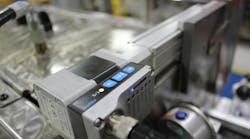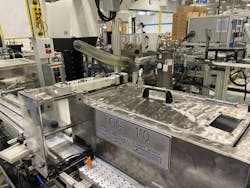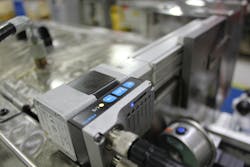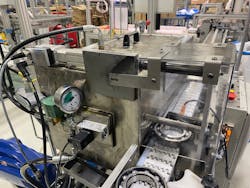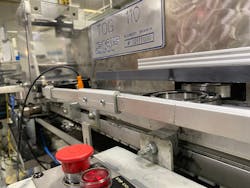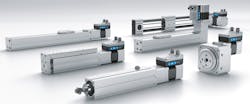Two years ago, Festo sales engineer Jim Ross and his colleague, electric automation business development specialist Nabil Salman, walked into Bo Askew’s office at the SKF USA in Flowery Branch, Ga. They told Askew that Festo would soon introduce a new low-cost family of electric axes. That immediately caught Askew’s attention.
Askew, the facility supervisor and machine reliability champion at the Flowery Branch roller bearing manufacturing plant, was looking for cost-effective electric options to replace pneumatic motion in order to lower energy consumption at the plant. Askew subsequently discovered that energy savings was only one of many advantages of these new all-in-one electric axes.
Ross and Salman explained that the new Simplified Motion Series (SMS) family of two position axes that would soon be available were priced similarly to pneumatic cylinders. He said that these all-in-one machine-mountable units saved cost and space by eliminating the need for having an external drive located in a control panel. Programing position, speed, torque and cushioning were simple and accomplished via the unit’s onboard interface, not on a computer.
Within the SMS family of actuators, there were ball screw, slide and rotary style units that covered most simple two-position motion applications. (Recently three position capability has been added to every axis in the family through IO-Link.) SMS axes offer easy integration with a PLC via digital I/O or IO-Link.
Askew ordered two units for testing, the 150- and 200-mm models of the EPCS ball screw cylinder. In the SMS family, the EPCS is the model most closely related to pneumatic cylinders. The EPCS has a rod that extends and retracts via ball screw rather than compressed air. Six weeks after the new units were purchased, the EPCS cylinders, among the first to be delivered, arrived along with M12 electrical connection cable and I/O hardware.
Askew knew just where he wanted to test the 150-mm unit—the roller bearing preservation machine where he could replace a 150-mm pneumatic cylinder with a 150-mm electric cylinder and have an apples-to-apples comparison of performance.
The TOG 110 Preservation Machine
Once SKF roller bearings are pressed into housings during manufacture, housings are sprayed with an anti-corrosive preservative. This is a simple operation that can be performed manually using a spray bottle. While visiting a SKF plant in Italy, Askew was intrigued by an automated anti-corrosion spay machine at that plant. He was attracted to its simplicity, speed and, most importantly, that it freed a team member from spraying duties to focus on more challenging tasks.
Flowery Branch then manufactured its own preservation machine based on a design by Askew. The TOG 110 Preservation Machine sprays anti-corrosion preservative on 100- and 110-mm roller bearings. This is a fully automated spraying machine. The machine does, however, require manual changeover of the home position on the 150-mm pneumatic cylinder to accommodate a new run of different-diameter housings.
In single file, housings travel down a conveyor to the TOG 110 entry point where housings are pulled by tooling one at a time into the machine via the retracting rod of the 150-mm pneumatic cylinder. The new bearing housing pushes the next in line ahead by one housing diameter deeper into the machine. Housings inside the machine slide forward between guide rails, with each housing eventually reaching the center point directly under the preservative spray nozzle. As one new housing is pulled into the machine, a sprayed housing at the end of the line is pushed out onto an exit conveyor.
Very little force is needed to move the bearings through the machine as the low-friction plastic flooring is coated by a layer of preservative residue from the spraying process. The TOG 110 with pneumatic cylinder has a 900 unit-per-hour cycle rate and is operated 24/7.
For the TOG 110 to function properly, every entering housing must be pulled into the machine and left at the same location every cycle. If the position when the housing enters the machine is off, the line of housings inside the machine begin to diverge backward or forward from the center point under the sprayer.
Divergence from placement at the center point has two consequences. An out-of-position bearing may have only a small part of its surface sprayed and need to be reworked. Or housings leaving the TOG 110 may be pushed tightly against the exit-guiderail and jam the line of housings within the machine. Jams are safety hazards as there is still force being exerted on housings from the pneumatic cylinder trying to retract.
To correct the fault, air had to be exhausted, and the cylinder rod attached to the tooling manually readjusted. Over a period of months adjustments from changeovers and incorrect positioning wear nuts and rod grooves down, which affects precision adjustment. Excessive wear warrants replacing the cylinders on average twice per year.
Test-Driving an Electric Axis
With the TOG 110 Preservation Machine misalignment problem in mind, Askew had an ideal test case for the Festo EPCS electric cylinder. Festo Electric Automation Specialist Salman began the process by providing remote training on the EPCS. The manufacturing team mounted the unit directly on top of the TOG 110 and connected the rod to the tooling. The similarity of the rod in both electric and pneumatic cylinders provided for a simple conversion.
With some trial-and-error, the EPCS was soon in operation. The team programmed the torque, speed, and the end and home positions—home being the exact location to pull a housing into the machine. PLC I/O programming was identical to that for a digital pneumatic valve, which made this step simple. The cylinder’s IO-Link capability provides diagnostic feedback.
Both torque and speed were set at a minimum level for optimum control and positioning when the rod retracts, pulling housings into the machine. For the return trip—the extension of the rod out to the pickup point for the next housing—there was no housing to control, so the speed was set high to increase cycle rate. A cycle rate of 1,500 per hour was achieved for the electric cylinder, an increase of 600 cycles per hour over the pneumatic cylinder’s 900.
Most importantly, every bearing entering the TOG 110 was precisely positioned so housings under the spray nozzle were centered for an in-specification dose of anti-corrosion fluid, and housings exited at the proper point, eliminating jams. When work needs to be done on the interior of the TOG 110, safety systems stop the machine. The electric cylinder does not produce stored energy in stop mode, which is a safety improvement.
Changeover is simply a matter of setting a new home position via the unit’s onboard interface. Since no physical adjustments need to be made, the electric cylinder undergoes less wear. After one year’s 24/7 service, the cylinder has not needed to be replaced; pneumatic cylinders would have been. Askew plans on installing SMS units on the plant’s grinding and honing machines as well as on the 200-mm preservation machine.
“After the EPCS was operating for nearly a year, I wrote Jim and Nabil to tell them how successful our joint test project of the electric cylinder had been,” Askew said. “I believe it is important to share successes and in doing so continue to motivate vendors and customers to explore new solutions that improve production.”
Electric Motion Bridges the Gap Between Pneumatics and Servo Motion
The Simplified Motion Series (SMS) from Festo represents an engineering breakthrough that combines the simplicity of pneumatics with the benefits of electric automation. SMS takes proven ball screw axes, toothed belt axes, mini slides, electric cylinders, piston rod and rotary actuators and integrates them with an onboard servo drive. Users commission two-position functionality via onboard push buttons with no additional software needed.
When controlled with IO-Link, which is a standard feature of SMS axes, positioning along the axis length is infinitely variable. When used like this, SMS axes offer a cost-effective alternative to more expensive and complex traditional servo motion. They are low cost when compared to traditional servo motion solutions and setup is simple, as pneumatics opens the door to applications that have previously been cost-prohibited to electrics—including conveyor material handling and applying electric motion in mobile applications.
Via IO-Link, technicians can remotely adjust movement parameters, including infinitely variable positions and speed. They can also copy and back up functions for parameter transfer and read functions of essential process parameters.
SMS actuators are applied in positioning, indexing, clamping, feeding and cut-to-length tasks where electric automation adds proficiencies and value. Ordering, inventory and replacement are streamlined as all of the components are integrated into a single unit with a unique part number. Units in the series include ELGS-BS ball screw, ELGS-TB toothed belt axis, EGSS mini slide, EPCS electric cylinder (The cylinder used by SKF), EPCE compact electric cylinder, ERMS rotary drive and ELGE toothed belt axis.
Both Digital I/O (DIO) and IO-Link control come standard with each unit. With DIO control, there are two positions available—home and a configurable endpoint. As stated above, IO-Link offers flexible positioning along the axis, like a traditional electromechanical axis.
PLC set up for DIO control is identical to programing a digital pneumatic valve with two digital outputs and two digital inputs. One digital output extends the axis and the other retracts it. And the digital inputs indicate when the axis has reached the extended position or the retracted position, just like proximity switches would function on a pneumatic actuator.
This similarity to a pneumatic valve simplifies PLC programing, reduces the number of I/O typically required for servo-controlled motion, and speeds up installation of single and multiple units. Integrated position feedback eliminates the need for proximity sensors.
Since the electronic components and modules are onboard the integrated drive, these actuators are machine-mountable. There is no external servo drive to mount in the control panel, which means minimal control panel overhead associated with these electric drives.
